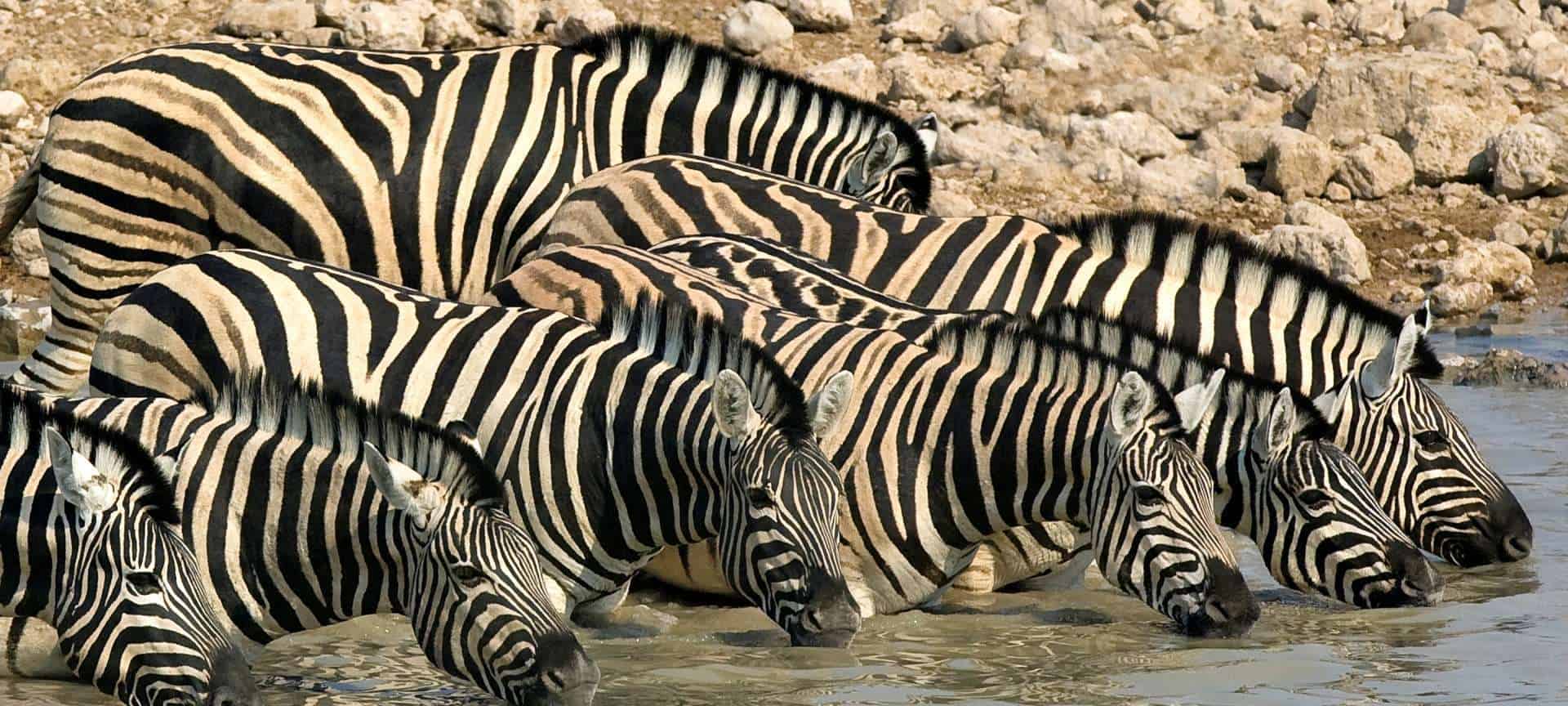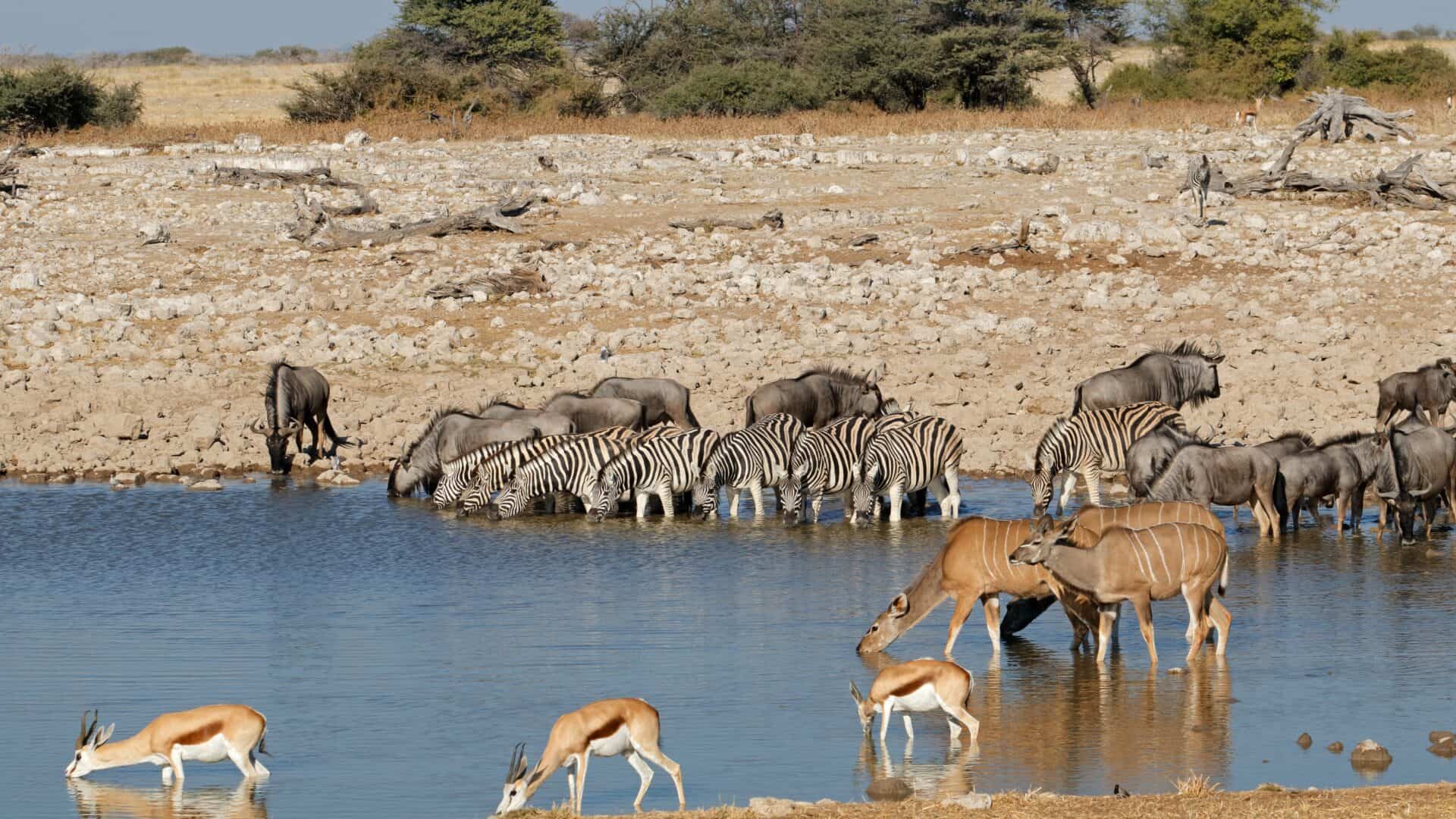This is probably the best-known part of Etosha National Park; the expanse of land fringing the eastern and southern rim of the enormous depression is the ancient salt pan itself. Nothing grows in the salty, lime-rich pan except algae.
Still, it and other smaller pans, such as Okahakana, are surrounded by grassland, mopane shrublands, and some woodland, and the area sustains a remarkable variety of life.
Of the Big Five, only buffalo don’t reside here – which is more than made up for by exceptional sightings of black rhinos, seldom seen in most other safari destinations.
The park’s 300-odd lions (the country’s core population) are relaxed around vehicles, and one study noted density was relatively high, at 1.8 lions per 100km2 (39 square miles).
Exploring Central and Eastern Etosha
Slinky, secretive leopards are, of course, harder to see, but certain waterholes are known to have a resident spotted cat.
Most visitors will drive to Etosha from the country’s capital, Windhoek. It’s 430km (267mi) up routes B1 and C38, an easy trip that takes around five hours. A quick orientation tour is helpful.
Visitors will enter this section of the park through either the southern Andersson Gate or Von Lindequist Gate in the east. A bit further north is King Nehale Lya Mpingana Gate, for those coming down from the Caprivi region, now called Zambezi.
Camps in this region are the older, government-run classics, renovated about a decade ago. There’s Namutoni, located inside the park’s eastern border, Halali, situated south of Etosha Pan, and Okaukuejo, near the pan’s eastern tip.
All will suit couples, solo travelers, and families happy with budget accommodation.
Guided game drives are available at all camps, morning, afternoon, and night. The C38 through the park links all three camps, and tempting loop roads slip off to waterholes along the way.
The names themselves are a delight, hinting at the essence of the place and the cultures that have lived here: Okaukuejo, for example, means the woman who had a child every year, the tongue-twisting Omumborombonga means leadwood tree, protected hardwoods that are rare in Namibia and grow at this pan, and Tgumses translates as “the soil deep in the hole is always wet.”
It’s worth remembering that an Etosha safari involves a harsh landscape that some might find unforgiving. Towards the end of the dry season, grazing around waterholes is depleted, and hooves clatter on stones as animals come down to drink. It is pretty primordial in ways but foregrounds the natural cycles that allow life to flourish even in tough places like this.
As the game tends to migrate east when the rains come, the Namutoni area is a good option. It’s also near Fischer’s Pan, a hotspot for migrant waterbirds (don’t miss the blushing pink flamingos) in the rainy season and cheetahs. Pretty makalani palms sway around waterholes on this side of the park.
An NWR ranger born in Namutoni recommends the Sandveld north of the camp for big herds of elephants and that giant among antelope, the eland.
The few White rhinos in the park (reintroduced in 1995) roamed the area between Namutoni and Halali at one stage. Look for them near the Springbokfontein waterhole. The old fort at Namutoni is a remarkable sight in the desert surroundings.
It was virtually obliterated by Owambo warriors at the turn of the 20th century but rebuilt within a few years. At all three classic camps, you can stay in chalets (some family chalets have a kitchenette, but most chalets aren’t fully self-catering), double rooms (in blocks of four) or the campsite, and there’s a restaurant, shop with basic supplies, a pool, and a fuel station.
Halali, which opened in 1967, has the same basic amenities and accommodations as Namutoni, although it’s slightly smaller. It, too, has a floodlit waterhole, more frequented by the coveted black rhino than Namutoni’s. It’s usefully situated, has an attractive setting below a hill, and boasts the odd honeymoon suite and a busy pool. The birding in camp is excellent.
Okaukuejo, opened in 1955, is the park’s oldest and largest camp and its large, floodlit waterhole is legendary. As a result, you may be elbow to elbow with others on the viewing stands, waiting for a black rhino to trundle down to drink. It’s the best place in Africa to see these volatile creatures.
The few waterhole rooms that overlook this prime territory are what to book if you’re lucky enough to get a slot! The camp is close to Andersson Gate, and the waterholes in the area are extremely popular. The grassy stretches west of Okaukuejo attract game in large numbers after the rains and are a calving hotspot.
The best accommodations in this region of Etosha National Park are at Onkoshi (opened in 2008), the newer solar-powered “luxury eco-camp” north of Namutoni. You’ll have to eat at the restaurant, and there is no waterhole here, so game is scarcer in winter.
It’s more intimate, with only 15 chalets on raised wooden decks, an infinity pool, and vast vistas. Only lodge guests can access the area (no self-driving visitors), so there is more peace and space, although prices beat the classic camps.
Wildlife photographers and co-authors of The Photographer’s Guide to Etosha National Park, Mario and Jenny Fazekas, cite this as their favorite camp for its photographic safari opportunities.
“The camp faces west and is situated right on the edge of the salt pan, so when the sun sets, you get magnificent landscape images of the sun reflecting off the water and silhouettes of flamingos, pelicans, and other waterbirds.”, they say.
One note on the area: there are reports that the park’s picnic sites and toilets are sadly neglected. Also, it’s not an exclusive luxury experience, aside from the quality of the game viewing!
Visitor numbers have surged, and overland trucks and tour buses, never mind numerous day visitors and tours, are a feature. Those who want good service, more attentive staff, and an exclusive experience should opt to stay outside the park.
Perfect Pan
Many of the area’s waterholes have a distinct character and are known for particular sightings; some even have ‘resident’ leopards (although never trust a guide who promises a leopard sighting; they can’t be guaranteed).
Pure bliss is finding a quiet spot to sit and listen, watch and wait for action, be it zebra jostling for a drink, streams of gorgeous sandgrouse flying in as black-backed jackals try and snap them from the air, or sudden drama as elephants arrive in rumbling groups to slake their thirst.
Anja Denker, a Namibian wildlife photographer who has visited the park six times in 2018 alone, cites one of her favorite waterholes as Salvadora, which has views stretching over the water to the horizon and the white mud that elephants coat themselves in.
“Salvadora’s backdrop makes for great photography and is always good for spotting lion prides, cheetahs, hyenas, and a variety of antelope that frequent the surrounding grassland all year round,” Denke says.
She also rates Chudob, near Namutoni, “for the sheer variety of game that congregates there, especially in the dry season.” It’s also excellent for giraffe drinking. Nebrownii is great for ghost-white elephants and lions.
Halali and Goas have reputations for leopards, as does Rietfontein, which is also a lion hang-out. Fischer pan is marvelous when covered in flamingos.
The Etosha Viewpoint
North of Halali camp and very close to Nuames Waterhole is a causeway that takes one out onto the cracked white mud of Etosha Pan itself (generally, you can’t drive on the pan surface). It’s the closest most of us will get to a lunar landscape.
Mirages can turn the horizon to static, and it’s a good place to feel the immensity and age of the pan: 100 million years old, once a massive lake fed by the Kunene River, which – inexplicably – changed course in some ancient tragedy. It can get mushy after rains when the road is closed, so consider this a dry season activity.
A Nest that’s a City
Look out for the remarkable structures built by sociable weavers. The name gives it away – these rather ordinary-looking birds know how to build a community.
Their enormous compound nest – the largest in the world – is crammed with independent chambers for young families, and a handful of neighbors help to feed any chicks.
Birdlife calls them “ecological engineers” as other species use the nests, often in ways we are yet to fully understand. A good spot to start looking for them is in Okaukuejo rest camp, although nests will weigh down larger trees across the park.
Pygmy falcons are associated with the nests too.
A Fairy Tale Forest
It’s the driest, least crowded “forest” you’re likely to see, but Sprookjeswoud, about 30km (19mi) west of Okuakuejo on the road to Grunewald waterhole, is otherworldly.
It means ghost or phantom forest and contains some gnarled African moringa trees, standing like lumpy figures in the bright light.
The San used to say the trees were thrown from heaven in anger and landed upside down (they have something a little baobab-like about them, with sparse leaves, but they are not related).
The Perfect Shot Mirages, Zebra Stripes, Water, Sky
A safari in Etosha National Park is a photographer’s dream, especially as animals obligingly trot down to waterholes in winter. Photographer Anja Denker says Etosha is a challenge due to the harsh light reflecting off the pan’s predominantly white soil and surface.
“The best light is in the early morning and late afternoon, with spectacular sunrises and sunsets to boot. It’s best to bring a long telephoto lens as sightings might be a fair distance away and a wide-angle to capture the landscape or the magnitude of a game which frequents the waterholes.”
Mario and Jenny Fazekas, authors of The Photographer’s Guide to Etosha National Park, agree that “a telephoto lens is critical.”
They also suggest familiarising yourself with your equipment before the trip.
They were once shooting a leopard at the floodlit Moringa waterhole at Halali, and a hapless guest baffled by her camera settings interrupted, asking them to take a shot for her!

Practical Advice
- Etosha National Park is Namibia’s flagship park and is so popular that it can be challenging to find room to stay in the government-run camps. Book well in advance.
- Etosha is enormous, and distances are extremely deceptive, especially if the 60kph (37mph) speed limit is taken into consideration. It’s larger than South Africa’s Kruger National Park, and driving just from Von Lindequist Gate to Okaukuejo, for example, is a hefty 140km (87mi) that averages 4.5 hours.
- Guests must check in at Namutoni or Okaukuejo upon arrival.
- Children are welcome at the classic camps, but no children under six at Onkoshi.
- You can book guided game drives, including at night when visitors may not drive themselves. This is an excellent way to see after-dark species.
- The classic camps usually have mobile phone reception.
- Self-driving photographers may find a copy of The Photographer’s Guide to Etosha helpful; it has excellent information on where to park, the best light, and what action can be expected or hoped for at various waterholes.
























